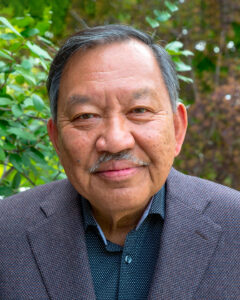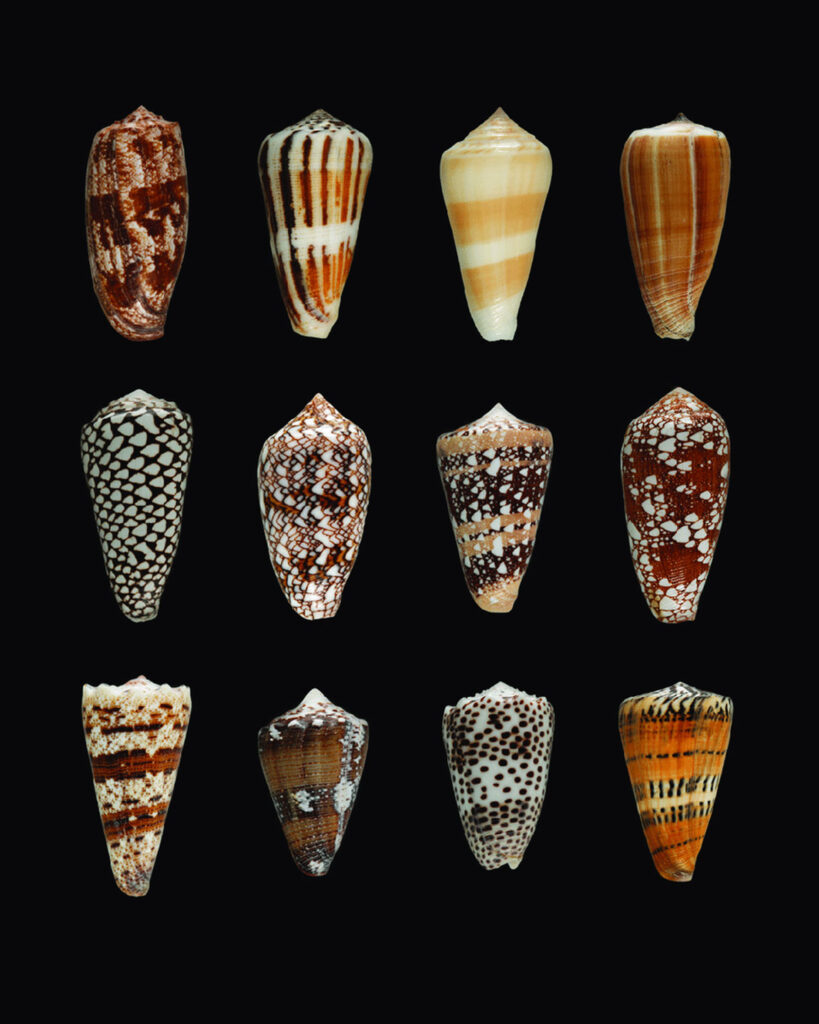Golden Goose Award

Baldomero "Toto" Olivera
A side hustle that transformed neuroscience.
As scientists working in the Philippines in the 1970s, biochemists Baldomero Olivera and Lourdes Cruz, professor emeritus of the University of the Philippines Diliman, found it tough to get hold of the right supplies for DNA research.
“We had to find something to do that didn’t require fancy equipment because we had none,” said Olivera, a distinguished professor at The University of Utah’s School of Biological Sciences, in a video produced for the Golden Goose awards.
Olivera and Cruz came up with what they hoped would be a fruitful side project. Cone snails are commonplace in the Philippines, and they had always fascinated Olivera, who had collected shells as a child. The pair decided to research the nature of the venom that the snails used to paralyze their tiny fish prey.

Cone Snail Shells
The team discovered the bioactive compounds in the venom were tiny proteins known as peptides. After moving to the US and teaming up with University of Utah grad students Dr. Michael McIntosh and the late Craig T. Clark, Olivera and Cruz learned that some of the venom peptides reacted differently in mice than in fish and frogs. It turned out in mammals the compounds were involved in the sensation of pain, rather than muscle paralysis.
“There was this incredible gold mine of compounds,” said McIntosh in the video. He is now a professor and director of research of psychiatry in the School of Biological Sciences at The University of Utah.
On September 14, 2022, the American Association for the Advancement of Science (AAAS), the world’s largest multidisciplinary scientific society, hosted the 11th annual Golden Goose Award ceremony, a celebration of federally funded research that unexpectedly benefits society. AAAS awarded University of Utah research of a non-opioid pain reliever, hidden in the venom of tiny cone snails, which greatly decreases pain for patients with chronic illnesses while helping scientists develop new ways to map the body’s nervous system. As undergraduate researchers, Craig Clark (in memoriam) and J. Michael McIntosh, now a professor of psychiatry at the U, isolated a compound that eventually led to an approved non-opioid pain killer. Baldomero M. Olivera, Distinguished Professor in the School of Biological Sciences, and Lourdes J. Cruz, then faculty of biology at the U and now Professor Emeritus at the University of the Philippines, supervised the research. The award recognizes all four individuals.
The Golden Goose Award spotlights scientific research that may have appeared obscure, sounded funny, or for which the results were unforeseen at the outset but ultimately, and often serendipitously, led to breakthroughs. This year, the award comes on the heels of the U.S. Congress passing and President Biden signing the bipartisan and historic CHIPS and Science Act. This new law reauthorizes key federal agencies whose projects will propel discovery, build on our strengths, and show what American investment, intellect, ingenuity and risk-taking can accomplish — precisely the type of innovation the Golden Goose Award honors.
U.S. Representative Jim Cooper (D-TN), often referred to as “Father Goose,” will retire from Congress at the end of this term. He conceived of the award as a strong counterpoint to criticisms of basic research as wasteful federal spending, such as the late Sen. William Proxmire’s (D-WI) Golden Fleece Award, leading to a coalition of business, university, and scientific organizations establishing the award in 2012. Thanks to his legacy, the award will continue to elevate the importance of recognizing basic science that ultimately improves people’s quality of life.
“The Golden Goose Award reminds us that potential discoveries could be hidden in every corner and illustrates the benefits of investing in basic research to propel innovation,” said Sudip S. Parikh, chief executive officer at AAAS and executive publisher of the Science family of journals. “AAAS is honored to elevate this important work since the award’s inception, and we thank Representative Cooper for his tireless leadership and dedicated support to this award and the scientific community.”
Tiny snail, big impact
In the 1970s, Olivera and collaborator Cruz were interested in the deadly venom used by cone snails, marine creatures native to the Philippines. When Olivera moved to the U, his focus shifted to other areas, but he kept the cone snail venom as a side project. In 1979 he assigned two undergraduate researchers the task of isolating the venom’s components and testing their impacts on mice. Craig Clark, a sophomore biology major, and McIntosh, a 19-year-old who just graduated high school, discovered something unexpected—a compound they named “shaker peptide” blocked calcium channels in the mice, which are the nerve’s ability to communicate with the rest of the body. Later, they found that the shaker peptide specifically targeted the channels related to pain in mammals and is 1,000 times as powerful as morphine. McIntosh is now a professor of psychiatry at the U with his own lab and thirty years later, continues to work with Olivera to explore the therapeutic potential of cone snail venom that has one of the most promising non-opioid alternatives to manage pain. One compound become an FDA-approved painkiller.

2022 Golden Goose Awards Ceremony
The student project of Clark and McIntosh is part of a long tradition of undergraduate research in the U’s College of Science. Fifty years ago, K. Gordon Lark, the first chair of the Department of Biology at the U, started an initiative to support undergrad research opportunities in faculty laboratories, an initiative that led to recruiting biology undergraduates such as Clark and McIntosh. The College of Science is expanding his legacy under a newly created Science Research Initiative, which provides most U science undergraduates with a unique opportunity to pursue their own independent research projects.
2022 Golden Goose Awardees:
Craig T. Clark (in memoriam), Lourdes J. Cruz (University of the Philippines), J. Michael McIntosh (University of Utah; George E. Wahlen VA Medical Center), and Baldomero Marquez Olivera (University of Utah)
Tiny Snail, Big Impact: Cone Snail Venom Eases Pain and Injects New Energy into Neuroscience
Impeded by supply chain issues while conducting DNA research in the Philippines, Lourdes Cruz and Baldomero Olivera began examining cone snails, a group of highly venomous sea mollusks which happened to be in abundant supply along the country’s coastal waters. Several decades and countless airline miles later, and with the help of then-undergraduate students Craig Clark and Michael McIntosh, the team discovered the raw material for a non-opioid pain reliever and a powerful new tool for studying the central nervous system, all hidden in the cone snail’s potent venom
Ron Kurtz (RxSight), Tibor Juhasz (ViaLase), Detao Du (Rayz Technologies), Gerard Mourou (Ecole Polytechnique), and Donna Strickland (University of Waterloo)
How a Lab Incident Led to Better Eye Surgery for Millions of People
Nearly 30 years ago, a graduate student at the University of Michigan’s Center for Ultrafast Optical Science (CUOS) experienced an accidental laser injury to his eye. Fortunately, his vision was not severely affected. However, the observation of the very precise and perfectly circular damage produced by the laser led to a collaboration. Eight years later, that group of researchers developed of a bladeless approach to corrective eye surgery. The new procedure, also known as bladeless LASIK, uses a femtosecond laser rather than a precision scalpel cut into the human cornea before it is reshaped to improve the patient’s vision.
Manu Prakash (Stanford University) and Jim Cybulski (Foldscope Instruments Inc.)
Foldscopes and Frugal Science: Paper Microscopes Make Science Accessible
While researching in remote areas of India and Thailand, a technical challenge piqued Manu Prakash’s curiosity. In certain areas of the world, transport, training, and maintenance barriers can make state-of-the-art microscopes inaccessible. Prakash found a potential solution in a decidedly un-technical material: paper. Using principles of origami applied to printer paper, matchboxes, and file folders, Prakash and graduate student Jim Cybulski designed a paper microscope known as the Foldscope that can achieve powerful magnification with materials that cost less than $1 to manufacture. Today, just over a decade later, two million Foldscopes have been distributed in over 160 countries and have been used to diagnose infectious diseases, diagnose new species, and identify fake drugs, among many other applications.



